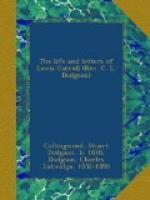3.
In
winter-time, all in a row,
The
happy skaters come and go. I c E
4.
“Papa!”
they cry, “Do let us stay!”
He
does not speak, but says they may. N o
D
5.
“There
is a land,” he says, “my dear,
Which
is too hot to skate, I fear.” A fric
A
At Margate also he met Miss Adelaide Paine, who afterwards became one of his greatest favourites. He could not bear to see the healthy pleasures of childhood spoiled by conventional restraint. “One piece of advice given to my parents,” writes Miss Paine, “gave me very great glee, and that was not to make little girls wear gloves at the seaside; they took the advice, and I enjoyed the result.” Apropos of this I may mention that, when staying at Eastbourne, he never went down to the beach without providing himself with a supply of safety-pins. Then if he saw any little girl who wanted to wade in the sea, but was afraid of spoiling her frock, he would gravely go up to her and present her with a safety-pin, so that she might fasten up her skirts out of harm’s way.
Tight boots were a great aversion of his, especially for children. One little girl who was staying with him at Eastbourne had occasion to buy a new pair of boots. Lewis Carroll gave instructions to the bootmaker as to how they were to be made, so as to be thoroughly comfortable, with the result that when they came home they were more useful than ornamental, being very nearly as broad as they were long! Which shows that even hygienic principles may be pushed too far.
The first meeting with Miss Paine took place in 1876. When Lewis Carroll returned to Christ Church he sent her a copy of “The Hunting of the Snark,” with the following acrostic written in the fly-leaf:—
‘A re you deaf, Father
William?’ the young man said,
’D id you hear what
I told you just now?
E xcuse me for shouting!
Don’t waggle your head
L ike a blundering,
sleepy old cow!
A little maid dwelling
in Wallington Town,
I s my friend, so I
beg to remark:
D o you think she’d
be pleased if a book were sent down
E ntitled “The
Hunt of the Snark?"’
‘P ack it up in brown
paper!’ the old man cried,
’A nd seal it with olive-and-dove.
I command you to do
it!’ he added with pride,
’N or forget, my good
fellow, to send her beside
E aster Greetings, and
give her my love.’
This was followed by a letter, dated June 7, 1876:—
My dear Adelaide,—Did you try if the letters at the beginnings of the lines about Father William would spell anything? Sometimes it happens that you can spell out words that way, which is very curious.
I wish you could have heard him when he shouted out “Pack it up in brown paper!”




